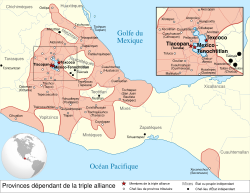Top Qs
Timeline
Chat
Perspective
Tlaxcala (Nahua state)
Pre-Columbian state in present-day central Mexico (1348–1520) From Wikipedia, the free encyclopedia
Remove ads
Tlaxcala (Classical Nahuatl: Tlaxcallān [t͡ɬaʃˈkalːaːn̥] ⓘ, 'place of maize tortillas') was a pre-Columbian city and state in central Mexico.
Tlaxcala was completely surrounded by Aztec lands, leading to intermittent armed conflict between the two powers as the latter attempted to absorb the former into its empire. In the reign of Motecuhzoma I, the Aztec Triple Alliance instituted a policy of instead fighting so-called "Flower(y) Wars" against Tlaxcala (as well as other city-states; namely, Huexotzinco and Cholula)—purportedly in order to obtain prisoners-of-war for ritual sacrifice—and imposed a trade embargo upon Tlaxcala specifically, in an apparent effort to weaken or punish the recalcitrant polity.[2]
This long history of conflict between the Aztecs and the Tlaxcalteca played a role in the course of events during the Spanish conquest of the Aztec Empire: the Tlaxcalteca—seizing the chance to strike back against their hated Aztec enemies—allied with the Spanish Empire, supplying a large contingent for the multi-ethnic, Spanish-led army that eventually destroyed the Empire.
Remove ads
History
Summarize
Perspective

The top-right hand sector is Tizatlan, bottom-right Quiahuiztlan, top-left Ocotelolco, and bottom-left Tepeticpac. The river Atzompa crosses the city from north to south (left to right, the map being oriented east–west). From Alfredo Chavero, Pinturas Jeroglíficas, Mexico 1901.

The Tlaxcalteca arrived in Central Mexico during the Late Postclassic. They first settled near Texcoco in the valley of Mexico, between the settlement of Cohuatlinchan and the shore of Lake Texcoco.[3] After some years the Tlaxcalteca were driven out of the valley of Mexico and moved to the east, splitting into three groups along the way. While one group continued north towards the modern state of Hidalgo, and another remained in the vicinity of Texcoco, a third group arrived in the modern valley of Tlaxcala, where they established the city of Tepetícpac Texcallan under the leadership of Culhuatecuhtli Quanex.
Over the subsequent years, the Tlaxcalan state expanded with the foundations of Ocotelulco and Tizatlán. The fourth major settlement, Quiahuiztlan, was founded by members of the Tlaxcalan group that had initially remained in the valley of Mexico.[3]
Remove ads
Government
Ancient Tlaxcala was a republic ruled by a council of between 50 and 200 chief political officials (teteuctin, pl.; sg. teuctli).[4][5][6] These officials gained their positions through service to the state, usually in warfare, and as a result came from both the noble (pilli) and commoner (macehualli) classes.
Culture
Three languages were spoken in Tlaxcala: Nahuatl, Otomi by a large minority, and "Pinome" (likely Popoloca) by a smaller minority.[7][8][9] Later, Aztec conquests resulted in further waves of Otomi migration to Tlaxcala, such as from Xaltocan. A dialect of Otomi is still spoken in Tlaxcala today.
Contact with conquistadors
Summarize
Perspective
Tlaxcala was never conquered by the Aztec Empire, but was engaged in a state of perpetual war, the so-called "flower wars" or "garland wars".
Conquistador Bernal Díaz del Castillo describes the first battle between the Spanish force and the Tlaxcalteca as surprisingly difficult; he writes that they—the Spanish—would probably have not survived, had not Xicotencatl the Elder and Maxixcatzin persuaded Xicotencatl the Younger, the Tlaxcalan warleader, that it would be better to ally with the newcomers than to kill them.[10]: 140–188 Xicohtencatl the Younger was later—in April 1521—condemned by the Tlaxcalan ruling council and hanged by Cortés, for desertion during the siege of Tenochtitlan.
Due to protracted warfare between the Aztecs and the Tlaxcalteca, the latter were eager to exact revenge, and soon became loyal allies of the Spanish. Even after the Spanish were expelled from Tenochtitlan, the Tlaxcalteca continued their support. Tlaxcala also assisted the Spanish in the conquest of Guatemala.[11]
As a result of the alliance with the Spaniards, Tlaxcala had hidalgo privileged status within "New Spain", as confirmed in the Royal Writ of the Foundation of the City of Tlaxcala, Mexico. After the Spanish conquered Tenochtitlan and the rest of Mexico, Tlaxcala was allowed to survive and preserve its pre-Columbian culture. In addition, as a reward for the unyielding loyalty the Tlaxcalan federation had shown the Spanish, the city and its inhabitants largely escaped the pillaging and destruction following the Spanish conquest. The Tlaxcalteca gave further assistance in the Mixtón War.

Following the Spanish Conquest, Tlaxcala was divided into four fiefdoms (señoríos) by the Spanish corregidor Gómez de Santillán in 1545 (26 years after the Conquest). These fiefdoms were Ocotelolco, Quiahuiztlan, Tepeticpac, and Tizatlan. At this time, four great houses or lineages emerged and claimed hereditary rights to each fiefdom and created fictitious genealogies extending back into the pre-Columbian era to justify their claims.[12][page needed]
During the colonial period, Tlaxcala's "part in the conquest of the Aztec 'empire,' its favored treatment by the Spanish crown, unique talent for propaganda and litigation and astonishing enterprise" gave the small state an important place in Mexican history.[13]
In the 16th and 17th centuries, Tlaxcalan settlers went to live in new northern colonies to protect Mexico from the Chichimeca.[14]
Remove ads
See also
- Tlaxcaltec – Nahuatl for inhabitants of Tlaxcala
- Tlaxcala – the present day Mexican state
- Tlaxcala, Tlaxcala – the present day capital of the state of Tlaxcala
References
Sources
Bibliography
External links
Wikiwand - on
Seamless Wikipedia browsing. On steroids.
Remove ads



